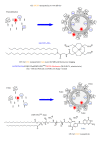Lipid-based nanoparticles in cancer diagnosis and therapy
- PMID: 23936655
- PMCID: PMC3725835
- DOI: 10.1155/2013/165981
Lipid-based nanoparticles in cancer diagnosis and therapy
Abstract
Today, researchers are constantly developing new nanomaterials, nanodevices, and nanoparticles to meet unmet needs in the delivery of therapeutic agents and imaging agents for cancer therapy and diagnosis, respectively. Of particular interest here are lipid-based nanoparticles (LNPs) that are genuine particles (approximately 100 nm in dimension) assembled from varieties of lipid and other chemical components that act collectively to overcome biological barriers (biobarriers), in order for LNPs to preferentially accumulate in or around disease-target cells for the functional delivery of therapeutic agents for treatment or of imaging agents for diagnosis. The capabilities of these LNPs will clearly vary depending on functional requirements, but the nanoscale allows for an impressive level of diversity in capabilities to enable corresponding LNPs to address an equally diverse range of functional requirements. Accordingly, LNPs should be considered appropriate vehicles to provide an integrated, personalized approach to cancer diagnosis and therapy in future cancer disease management.
Figures



Similar articles
-
Nano-Based Therapy for Treatment of Skin Cancer.Recent Pat Antiinfect Drug Discov. 2018;13(2):151-163. doi: 10.2174/1574891X13666180911095440. Recent Pat Antiinfect Drug Discov. 2018. PMID: 30205801 Review.
-
Lipid-based nanoparticles for treatment of cancer.Heliyon. 2022 May 13;8(5):e09403. doi: 10.1016/j.heliyon.2022.e09403. eCollection 2022 May. Heliyon. 2022. PMID: 35663739 Free PMC article. Review.
-
Shape Matters: Comprehensive Analysis of Star-Shaped Lipid Nanoparticles.Front Pharmacol. 2020 Apr 30;11:539. doi: 10.3389/fphar.2020.00539. eCollection 2020. Front Pharmacol. 2020. PMID: 32425785 Free PMC article.
-
Developing Biodegradable Lipid Nanoparticles for Intracellular mRNA Delivery and Genome Editing.Acc Chem Res. 2021 Nov 2;54(21):4001-4011. doi: 10.1021/acs.accounts.1c00500. Epub 2021 Oct 20. Acc Chem Res. 2021. PMID: 34668716 Review.
-
Hydrophobic scaffolds of pH-sensitive cationic lipids contribute to miscibility with phospholipids and improve the efficiency of delivering short interfering RNA by small-sized lipid nanoparticles.Acta Biomater. 2020 Jan 15;102:341-350. doi: 10.1016/j.actbio.2019.11.022. Epub 2019 Nov 13. Acta Biomater. 2020. PMID: 31733331
Cited by
-
An Overview of Polymeric Nanoparticles-Based Drug Delivery System in Cancer Treatment.Technol Cancer Res Treat. 2023 Jan-Dec;22:15330338231152083. doi: 10.1177/15330338231152083. Technol Cancer Res Treat. 2023. Retraction in: Technol Cancer Res Treat. 2024 Jan-Dec;23:15330338241276300. doi: 10.1177/15330338241276300. PMID: 36718541 Free PMC article. Retracted. Review.
-
Optimized Apamin-Mediated Nano-Lipidic Carrier Potentially Enhances the Cytotoxicity of Ellagic Acid against Human Breast Cancer Cells.Int J Mol Sci. 2022 Aug 21;23(16):9440. doi: 10.3390/ijms23169440. Int J Mol Sci. 2022. PMID: 36012704 Free PMC article.
-
Supramolecular lipid nanoparticles as delivery carriers for non-invasive cancer theranostics.Curr Res Pharmacol Drug Discov. 2021 Oct 28;2:100067. doi: 10.1016/j.crphar.2021.100067. eCollection 2021. Curr Res Pharmacol Drug Discov. 2021. PMID: 34909685 Free PMC article. Review.
-
Construction of ultrasonic nanobubbles carrying CAIX polypeptides to target carcinoma cells derived from various organs.J Nanobiotechnology. 2017 Sep 29;15(1):63. doi: 10.1186/s12951-017-0307-0. J Nanobiotechnology. 2017. PMID: 28962657 Free PMC article.
-
Preclinical evaluation of an O(6)-methylguanine-DNA methyltransferase-siRNA/liposome complex administered by convection-enhanced delivery to rat and porcine brains.Am J Transl Res. 2014 Jan 15;6(2):169-78. eCollection 2014. Am J Transl Res. 2014. PMID: 24489997 Free PMC article.
References
-
- Ferrari M. Cancer nanotechnology: opportunities and challenges. Nature Reviews Cancer. 2005;5(3):161–171. - PubMed
-
- Srinivas PR, Barker P, Srivastava S. Nanotechnology in early detection of cancer. Laboratory Investigation. 2002;82(5):657–662. - PubMed
-
- Nie S, Xing Y, Kim GJ, Simons JW. Nanotechnology applications in cancer. Annual Review of Biomedical Engineering. 2007;9:257–288. - PubMed
-
- Wang MD, Shin DM, Simons JW, Nie S. Nanotechnology for targeted cancer therapy. Expert Review of Anticancer Therapy. 2007;7(6):833–837. - PubMed
-
- Miller AD. Towards safe nanoparticle technologies for nucleic acid therapeutics. Tumori. 2008;94(2):234–245. - PubMed
LinkOut - more resources
Full Text Sources
Other Literature Sources
